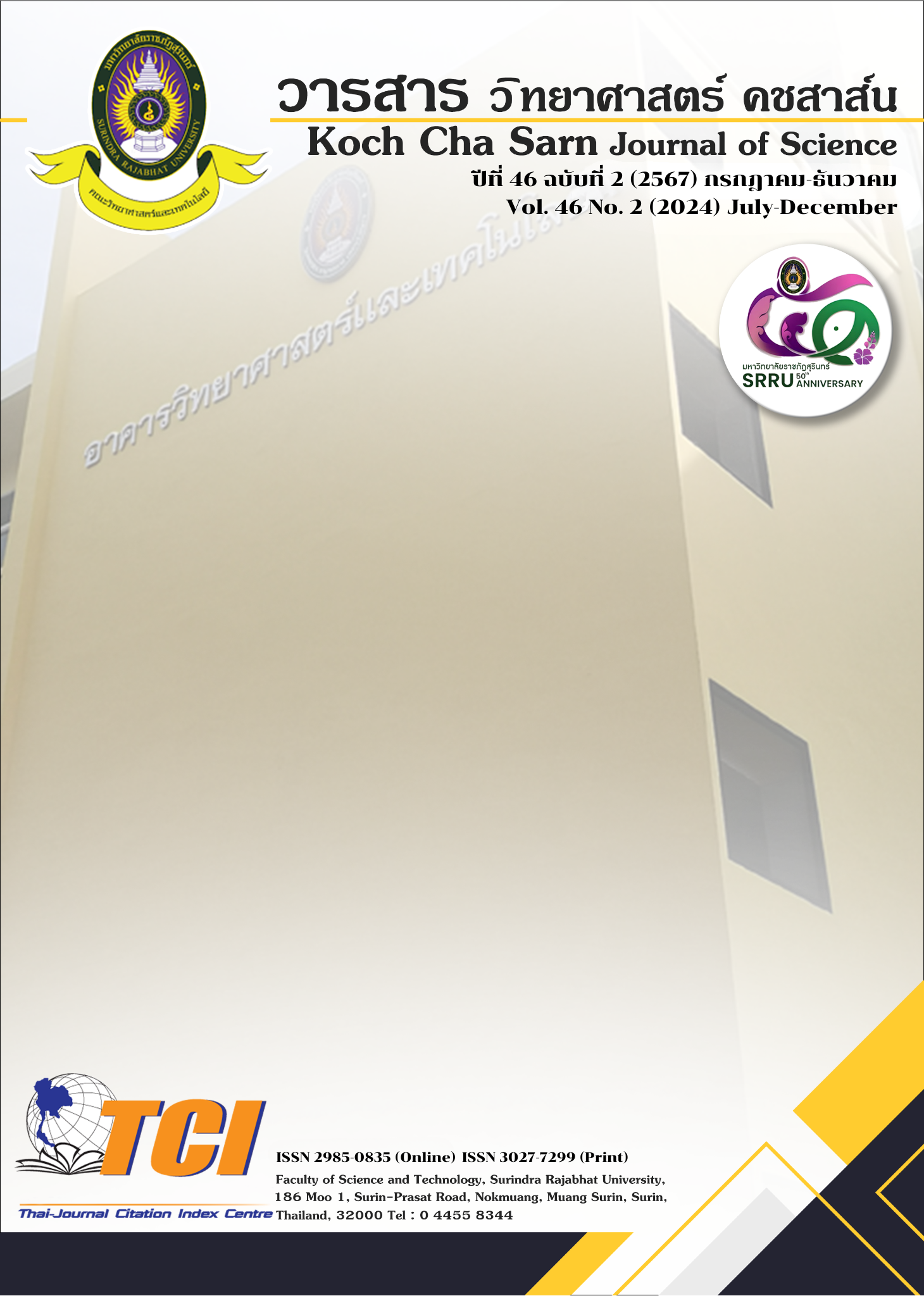Chemical Use Behavior of Farmers and the development of guidelines for reducing the use of chemicals in durian production for export, Karo Subdistrict, Nopphitam District, Nakhon Si Thammarat Province
DOI:
https://doi.org/10.14456/kcsj.2024.9Keywords:
GAP, Durian, PesticideAbstract
Nowadays, some agriculturists still have incorrect behavior of using agriculturally chemical substances with no proper protection. Thus, this is absolutely risky to directly contact and being jeopardized from such chemical substances. The objective of this participatory research was to develop an approach for encouraging more farmers to use Good Agricultural Practices (GAP) and reduce their chemical use. Data were collected from 32 farmers in Nopphitam District using the in-depth interview method. The majority of farmers said that they always followed the recommended procedures before, during, and after using agricultural chemicals. Some farmers were selected by purposive sampling to create an export quality durian producing model orchard patch for the research. The patch was divided into two zones, one in which agricultural chemicals were used, and one in which no chemicals were used. The soil had a medium level of organic matter content and low levels of major and minor plant nutrients. The nutrient with the lowest measurement was phosphorus and the highest was sulfur. Because the area was characterized by uneven elevation, the distribution of chemical fertilizers was uneven. When GC-MS/MS method was used to measure organophosphate, carbamate, organochlorine, and pyrethroid groups of pesticide residues in the soil, water and durian fruits from both zones of the model orchard patch, no residues were detected. We can conclude that the farmers in this area have a good level of knowledge about how to use agricultural chemicals properly. Farmers should pass GAP certification to create sustainability in their production from the point of view of the farmers themselves, consumers, the environment, and foreign export customers.
Keywords: GAP, Durian, Pesticide
Downloads
References
Tantrakonnsab W, Tantrakoonsab N. 2018 Thai Export of Durian to China. In: Kubo K, Sakata S, editors. Thai export of durian to China. Impact of China’s increasing demand for agro produce on agricultural production in the Mekong region. BRC Research Report No. 21 Edited by.Bangkok Research Center, JETRO Bangkok. Bangkok; 2018. p. 1-25
กรมวิชาการเกษตร. การจัดการการผลิตทุเรียน. [อินเทอร์เน็ต]. 2564 [เข้าถึงได้เมื่อ 10 พฤศจิกายน 2565] เข้าถึงได้จาก: https://www.doa.go.th/hort/wp-content/uploads/2020/01/การผลิตทุเรียน.pdf.
สำนักงานนโยบายและยุทธศาสตร์การค้า. ทุเรียนราชาแห่งผลไม้ไทยถูกใจคนต่างแดน. [อินเทอร์เน็ต]. 2563
[เข้าถึงได้เมื่อ 1 พฤศจิกายน 2565]. เข้าถึงได้จาก: http://www.tpso.moc.go. th/sites/default/
files/thieriiyn_240863.pdf
สำนักงานเศรษฐกิจการเกษตร. 2563. สถานการณ์การตลาดและต้นทุนในการผลิตทุเรียน [อินเทอร์เน็ต]. 2563
[เข้าถึงได้เมื่อ 1 พฤศจิกายน 2565]. เข้าถึงได้จาก: https://www.oae.go.th/view/1/%E0%B8%AB%E0%B8%99%E0%B9%89%E0%B8%B2%E0%B9%81%E0%B8%A3%E0%B8%81/TH-TH
ยุทธศาสตร์ระบบอาหารจังหวัดนครศรีธรรมราช. เอกสารประกอบการประชุมยุทธศาสตร์ระบบอาหารจังหวัดนครศรีธรรมราชปี พ.ศ.2562-2566 [อินเทอร์เน็ต]. 2561 [เข้าถึงได้เมื่อ 1 พฤศจิกายน 2565]. เข้าถึงได้จาก: https://saiyai.rmutsv.ac.th/images/admission/pdf/2172561.pdf
Mankeb P, Limunggura T, Ingo A, Chulilung P. Adoption of Good Agricultural Practices by Durian Farmers in Koh Samui District, Surat Thani Province, Thailand. Conference: Society for Social Management Systems (SSMS); 2013 December 2-4, Australia. 2013.
วนิดา เหรียญทอง, เฉลิมศักดิ์ ตุ้มหิรัญ, จินดา ขลิบทอง. แนวทางการส่งเสริมการผลิตทุเรียนของเกษตรกรในอำเภอท่าแซะ จังหวัดชุมพร. การประชุมเสนอผลงานวิจัยระดับชาติ มหาวิทยาลัยสุโขทัยธรรมาธิราช ครั้งที่ 8. วันที่ 23 พฤศจิกายน 2561; ณ อาคารเฉลิมพระเกียรติ 80 พรรษา 5 ธันวาคม 2550 ฝ่ายส่งเสริมมาตรฐานบัณฑิตศึกษา สำนักบัณฑิตศึกษา มหาวิทยาลัยสุโขทัยธรรมาธิราช; 2561.
Guddanti N. Impact of Good Agricultural Practices (GAP) on Small Farm Development: Knowledge and Adoption levels of Farm Women of Rainfed Areas. Indian Research Journal of Extension Education 2015; 15(4):153-6.
ภัทรา ขายมาน, อิสริยา บุญญะศิริ, ประพิณวดี ศิริศุภลักษณ์. ปัจจัยที่มีอิทธิพลต่อการตัดสินใจเข้าสู่ระบบมาตรฐานปฏิบัติทางการเกษตรดีที่เหมาะสมของเกษตรกรผู้ปลูกทุเรียนในจังหวัดจันทบุรี.การประชุมเสนอผลงานวิจัยระดับชาติ มหาวิทยาลัยสุโขทัยธรรมาธิราช ครั้งที่6. วันที่ 25 พฤศจิกายน 2559; ณ อาคารเฉลิมพระเกียรติ 80 พรรษา 5 ธันวาคม 2550 ฝ่ายส่งเสริมมาตรฐานบัณฑิตศึกษา สำนักบัณฑิตศึกษา มหาวิทยาลัยสุโขทัยธรรมาธิราช; 2559.
สำนักงานมาตรฐานสินค้าเกษตรและอาหารแห่งชาติ. มาตรฐานสินค้าเกษตร. [อินเทอร์เน็ต]. 2556
[เข้าถึงได้เมื่อ 1 พฤศจิกายน 2565]. เข้าถึงได้จาก: https://www.acfs.go.th/standard/download/GAP_
food%20crop.pdf.
สำนักงานพัฒนาการวิจัยการเกษตร (องค์กรมหาชน). ทุเรียน Durian. [อินเทอร์เน็ต]. 2564
[เข้าถึงได้เมื่อ 1 พฤศจิกายน 2565]. เข้าถึงได้จาก:https://www.arda.or.th/kasetinfo/south/durian/controller/index.php
Schreinemachers P, Schad I, Tipraqsa P, Williams PM, Neef A, Riwthong S, Sangchan W, Grovermann C. Can public GAP standards reduce agricultural pesticide use? The case of fruit and vegetable farming in northern Thailand. Agriculture and Human Values 2012; 29(4):519-29.
สาคร ศรีมุข. 2563. ผลกระทบจากการใช้สารเคมีทางการเกษตรของประเทศไทย. สำนักงานเลขาธิการวุฒิสภา.[อินเทอร์เน็ต]. 2563 [เข้าถึงได้เมื่อ 1 พฤศจิกายน 2565]. เข้าถึงได้จาก: http://library.senate.go.th/document/Ext6409/6409657_0002.PDF.
สุธาสินี อั้งสูงเนิน. ผลกระทบต่อสิ่งแวดล้อมจากการใช้สารเคมีกำจัดศัตรูพืช. วารสารวิชาการมหาวิทยาลัยอีสเทิร์นเอเชีย ฉบับวิทยาศาสตร์และเทคโนโลยี 2558;9(1): 50-63.
Amekawa Y. Reflections on the growing influence of good agricultural practices in the Global South. Journal of Agricultural and Environmental Ethics 2009;22:531–57.
กรมพัฒนาที่ดิน กระทรวงเกษตรและสหกรณ์. คู่มือการปฏิบัติงานกระบวนการวิเคราะห์ตรวจสอบดินทางเคมี. [อินเทอร์เน็ต]. 2553 [เข้าถึงได้เมื่อ 1 พฤศจิกายน 2565]. เข้าถึงได้จาก:
https://www.ldd.go.th/PMQA/2553/Manual/OSD-03.pdf
Mclean EO Soil pH and Lime Requirement. In: Page AL, editors. Methods of Soil Analysis: Part 2. Chemical and Microbiological Properties. 1st ed. Madison: American Society of Agronomy, Soil Science Society of America, 1982. p. 199-224.
Schofield RK, Taylor AW. The measurement of soil pH. Soil Sci. Soc. Am. Proc 1955;19:164–7.
Nelson DW, Sommer LE. Total Carbon, Organic Carbon and Organic Matter. In: Page AL, editors. Methods of Soil Analysis: Part 2. Chemical and Microbiological Properties. 1st ed. Madison: American Society of Agronomy, Soil Science Society of America, 1982. 595-579.
Bremner JM, Mulvaney CS. Nitrogen-Total. In: Page AL, editors. Methods of Soil Analysis: Part 2. Chemical and Microbiological Properties. 1st ed. Madison: American Society of Agronomy, Soil Science Society of America, 1982. 595-624.
Olsen SR, Sommers LE. Phosphorus. In: Page AL, editors. Methods of Soil Analysis: Part 2. Chemical and Microbiological Properties. 1st ed. Madison: American Society of Agronomy, Soil Science Society of America, 1982. 403-430.
Knudsen D, Peterson GA, Pratt P. Lithium, Sodium and Potassium. In: Page AL, editors. Methods of Soil Analysis: Part 2. Chemical and Microbiological Properties. 1st ed. Madison: American Society of Agronomy, Soil Science Society of America, 1982. 225-246.
Lanyon LE, Heald W.R. Magnesium, calcium, strontium and barium. In: Page AL, editors. Methods of Soil Analysis: Part 2. Chemical and Microbiological Properties. 1st ed. Madison: American Society of Agronomy, Soil Science Society of America, 1982. 247-262.






